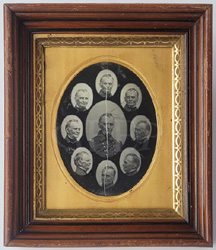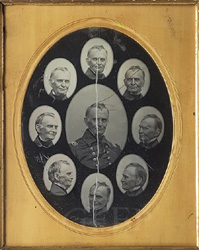U.S. NAVY COMMODORE CHARLES MORRIS
WHOLE PLATE MEDALLION DAGUERREOTYPE BY SOUTHWORTH & HAWES
$10,000. USD
This is an example of the "MEDALLION" aesthetic. Medallion daguerreotypes are decidedly uncommon, and whole plate Medallion daguerreotypes by Southworth & Hawes are exceedingly rare.
Morris was born in Woodstock, Connecticut on July 26, 1784. After being appointed a midshipman in July 1799, he served in the Quasi-War with France, the First Barbary War, the Second Barbary War, and the War of 1812. In 1812, Morris was appointed first lieutenant of USS Constitution, under the command of Isaac Hull, during her battle with HMS Guerriere, in which action Morris was severely wounded. He was promoted to captain in March 1813. In 1814, he commanded USS Adams in raiding expeditions against British commerce.
Morris, in command of a squadron (his flagship USS Constitution accompanied by the USS John Adams) went on assignment to South America, They voyaged up the Plata River to continue the negotiations to establish friendly relations with the new Latin American republics and to protect American commerce from South American privateers. After visiting Montevideo and Buenos Aires, both ships returned to the United States, arriving at Hampton Roads on 24 April 1820.
Commodore Charles Morris served as a Navy Commissioner from 1823 to 1827. Later, Morris commanded the Mediterranean Squadron and served as the chief of the Bureau of Ordnance. He was elected an Associate Fellow of the American Academy of Arts and Sciences in 1840. He served as the Chief of the Bureau of Construction, Equipment and Repairs from 1844 to 1847.
Charles Morris died at his home in Washington, D.C. on January 27, 1856, from a lung ailment. At the time of his death, he was the second highest-ranking officer in the Navy after Charles Stewart. He was buried at Oak Hill Cemetery in Washington, D.C., near the large family mausoleum built by his son-in-law, William Wilson Corcoran. Corcoran paid for a large, decorative headstone to be placed at the grave.
Ships in the United States Navy have been named USS Morris and USS Commodore Morris for him. Charles Morris Court, a street inside the Washington Navy Yard in Washington, D.C., is named after him. Charles Morris Avenue, a street inside the Portsmouth Naval Shipyard in Kittery, Maine, is named after him.
(Most of the above biographical information was gleaned from Wikipedia.)
Recommended reading: The Autobiography of Commodore Charles Morris, U.S.N., as featured on the U.S. Naval Institute website.
SIZE. Whole plate is the largest daguerreotype regulated size, which is 8 1/2 x 6 1/2 inches. Whole plates are scarce and anything larger is rare.
HOUSING. Ogee frame.
CONDITION. Noticeable vertical scratch. Many other scratches. Poor condition.
APPEARANCE. The Medallion format is truly special. In this rare example, we admire Commodore Charles Morris from nine different perspectives.

